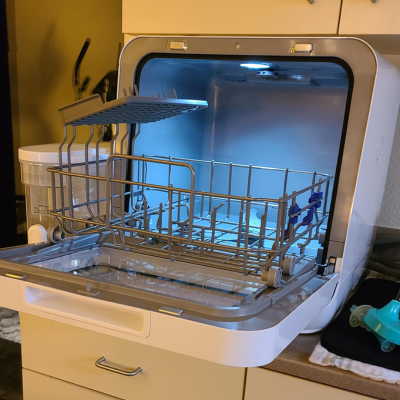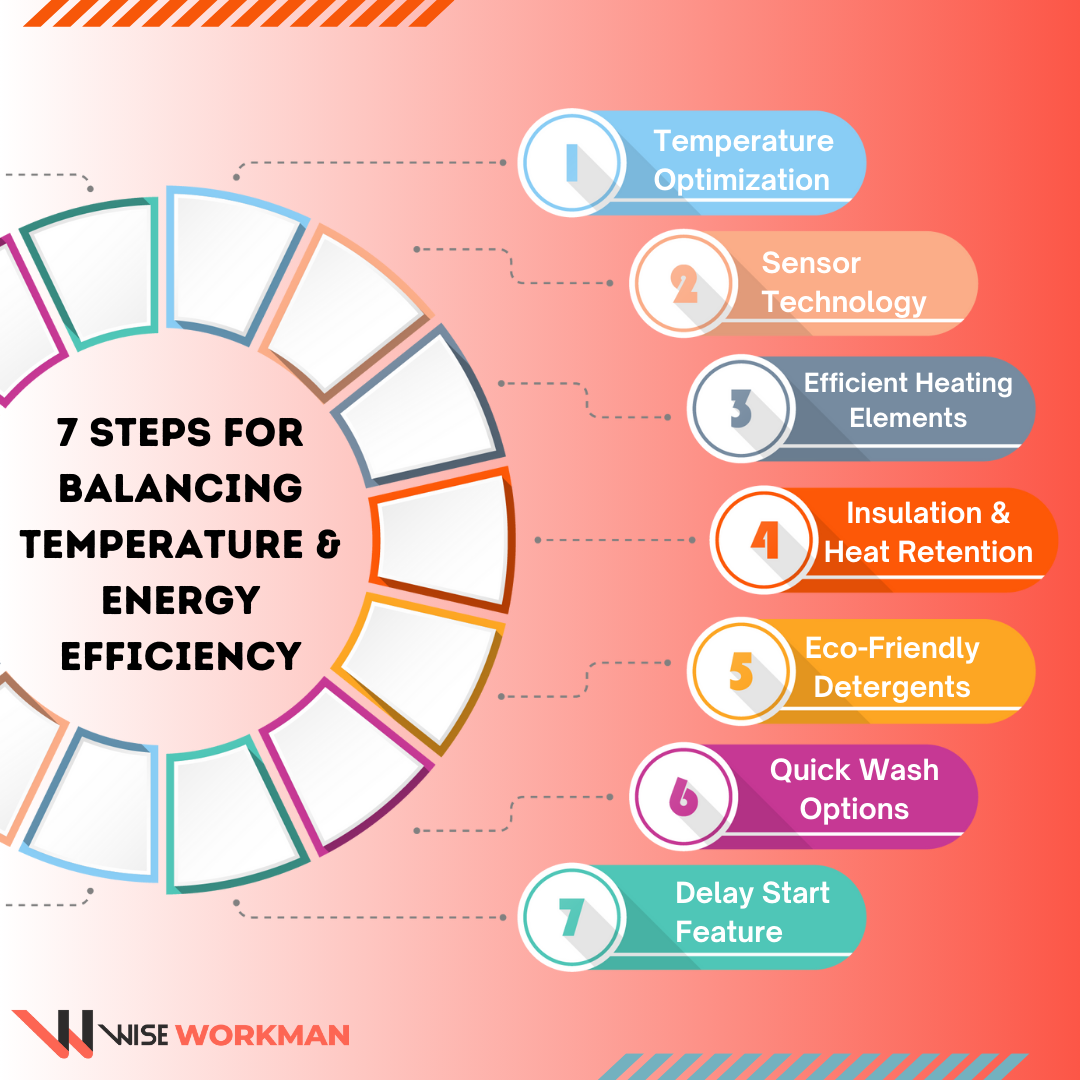Dishwashers are necessary in modern kitchens because they make washing and sanitizing dishes much easier. While these machines are convenient, one important aspect that is sometimes disregarded is the dishwasher temperature's role in ensuring efficient cleaning and sanitization.
The effectiveness of a dishwasher and its capacity to get rid of dangerous bacteria and germs both heavily depend on the temperature at which it runs.
An essential component of dishwasher performance is water heating. In addition to efficiently dissolving oil and dirt, hot water also helps sanitize dishes by eradicating potentially hazardous germs.
You may be wondering how hot do dishwashers get. Proper temperature management is crucial to maximize dishwashing efficiency, reduce the need for excessive detergent usage, and minimize residue accumulation on dishes. Additionally, it ensures that your cookware is clean and safe to use after it is finished.
We will explore dishwasher temperature, its function in sanitization, and how you may make the most of your dishwasher's capacity for pristine, germ-free dishes in this investigation.
Dishwashers are intended to clean and sterilize dishes thoroughly, and a key factor in attaining this goal is the temperature settings at which they work. Different dishwashing cycle temperatures are designed to offer the best possible cleaning and hygienic conditions.

In this section, we'll examine the temperature ranges that dishwashers commonly experience across several cycles and their cleaning effectiveness. Read on to explore more about dishwasher temperature levels!
| Dishwasher Cycle | Temperature Range | Description |
|---|---|---|
| Normal Wash Cycle | 120-140°F (49-60°C) | Default option for ordinary dishwashing; effectively removes food particles and oil from plates using hot water between 120 and 140 degrees Fahrenheit. |
| Heavy-Duty Cycle | Approximately 140-160°F | For extremely filthy dishes and kitchenware; uses hotter water temperatures, often between 140°F and 160°F, to efficiently remove stubborn, baked-on food stains. |
| Eco-Friendly Cycle | Approximately 115-125°F | Uses less energy and runs at temperatures between 115 and 125 °F; a more environmentally friendly option, though not as efficient at removing difficult residues. |
| Rinse Cycle | Around 140°F (60°C) | Primarily used during the rinse cycle to remove leftover soap and residue from dishes; helps prevent soap and mineral buildup. |
| Sanitizing Cycle | Typically exceeds 160°F | Intended to achieve extremely high temperatures, generally exceeding 160°F, to ensure complete disinfection; ideal for items requiring a high standard of sanitation. |
| Quick Wash Cycle | Around 110-130°F (43-54°C) | Utilizes water between 110 and 130 degrees Fahrenheit for a quicker cleaning time; suitable for mildly dirty dishes not needing full cleaning power. |
| Delay Start/Pre-Wash | Varies | More for convenience and prepping dishes; employ temperatures similar to the rinse or eco-friendly cycle. |
It's crucial to comprehend the temperature ranges that dishwashers normally attain during the various cycles if you want to maximize the cleaning and sanitization of your dishes.
You may get consistently clean and sanitary results while using resources wisely by selecting the appropriate cycle based on the degree of soiling and your environmental concerns.
Dishwashers are useful kitchen equipment that saves time by effectively cleaning your dishes using several different techniques. Heating components are one of these processes that is essential to the cleaning process.
This section will help you understand dishwasher heating and how it affects cleaning effectiveness.
The heating mechanisms in dishwashers contribute significantly to the cleaning efficiency in the following ways:
Prevention of water spots: The rinse aid, which is frequently used in conjunction with the drying heating element, aids in preventing water spots and streaks on dishes and glassware. It encourages uniform drying and makes dishes appear immaculate.
Energy Efficiency: Modern dishwashers use heating mechanisms instead of manual washing and drying to efficiently clean and dry dishes, consuming less energy overall and negatively impacting the environment.
Understanding how dishwashers help the cleaning process requires understanding the heating processes within these equipment.
In addition to being very clean, your dishes will also be properly dried, free of water stains, and thoroughly sanitized thanks to the combination of a drying heating element, a heating element for the water, and an optional rinse assist dispenser.
Because of this, dishwashers are a useful addition to any kitchen since they save time and provide consistently clean, well-kept dinnerware.
What can a water temperature's impact be on dishwashing? Keep reading to find out:
An essential part of the dishwashing procedure, hot water is crucial for dissolving grease, eliminating stains, and sanitization efficiency.
By understanding hot water's role in dishwashing, we may better comprehend the value of dishwashers in preserving clean and sanitary dinnerware.
To ensure complete cleaning, the high-temperature aids in separating the oil from the dish's surface.
Because of this, the hot water not only removes the stains off the dishes but also aids in preventing their redeposition on other dishwashing items.
This is especially important for objects that demand a high level of sanitation, such as infant bottles, chopping boards, and food containers.
Hot water aids in the detergent's more efficient breakdown of oil and food residues, enabling it to attach to these particles and remove them during the rinse cycle.
Hot water speeds up the chemical interactions detergents have with soils, removing even the toughest stains and cleaning dishes completely.
Using hot water to wash dishes has many advantages, including effectively removing oil and stains and sanitizing dishes. The action of the detergent, combined with its capacity to soften and dissolve grease and stains, results in dependably clean and sanitary plates.
The use of hot water, whether in a dishwasher or while hand-washing dishes, guarantees that your dinnerware is not only aesthetically pleasing but also fit for use, making it an essential component of preserving a healthy kitchen environment.
Modern eco-friendly dishwashing and energy-efficient appliances are made to achieve a delicate balance between lowering running costs and environmental impact and high-temperature cleaning for efficient dishwashing.
This part will look at how dishwashers balance temperature and energy efficiency.

However, dishwashers provide environmentally friendly or energy-saving cycles that operate at lower temperatures, often between 115 and 125°F (46 and 52°C).
Thanks to this temperature fluctuation, users may match their cleaning requirements with their energy usage.
Sensors keep track of things like water turbidity and water heating time. To save energy, the dishwasher may select a shorter cycle with lower temperatures if the dishes are just mildly dirty.
In comparison to earlier models, they consume less energy, assuring energy economy even when cleaning at high temperatures.
This implies that the appliance can maintain the target temperature of the water without using a lot of energy after it has been reached. This insulation helps with energy efficiency and effective cleaning.
Since these detergents are designed to function well even at low temperatures, less energy is used overall while still getting the job done.
This function makes sure that the dishwasher runs when power is less expensive, cutting down on overall energy expenditures.
The synergy between high-temperature cleaning and energy economy is best demonstrated by contemporary dishwashers. These appliances give consumers the ability to combine their cleaning demands with responsible energy consumption thanks to their cutting-edge features, effective heating components, and flexible wash cycles.
Modern dishwashers provide a practical solution that guarantees dishes are spotlessly clean while reducing the impact on the environment and household budgets as customers grow more conscious of environmental concerns and energy prices.

Even while hot water is used to clean dishwasher dishes successfully, safety issues must be considered, especially those involving the possibility of burns and scalds.
In this section, we'll talk about crucial safety precautions to take when working with dishwasher temperature control to avoid such mishaps.

Maintaining a secure kitchen environment requires ensuring dishwasher safety, especially when it comes to preventing burns and scalds. You may take advantage of the convenience of a dishwasher while lowering the danger of mishaps and injuries by adhering to these safety precautions and being aware of temperature-related concerns.
A recap of temperature and how hot do dishwashers get insights shows that it is critical to have a basic awareness of dishwashing temperature levels to achieve both successful cleaning and kitchenware safety.
Dishwashers are complicated devices made to maximize effective cleaning and safety. A key element in this equation is the temperature at which your dishwasher runs.
Dishes are guaranteed to be not only visually clean but also free of hazardous bacteria and germs with the proper understanding of dishwasher temperature. It ensures both a spotless appearance and a hygienic environment, improving your household's general health and well-being.
We have discussed the science underlying dishwasher temperature, its function in sanitization, and how you may use this information to get the most out of your appliance in this investigation.
You may use less detergent, avoid residue accumulation, and, most importantly, have peace of mind knowing your dishes are clean and suitable for regular use by paying attention to temperature settings.
So keep in mind that the secret to both spotless, germ-free dishes and kitchen safety is mastering the temperature settings in your dishwasher.